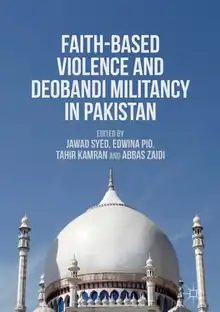 English cover | |
| Editors |
|
|---|---|
| Country | United Kingdom |
| Language | English |
| Subject | Deobandi movement in Pakistan |
| Publisher | Palgrave Macmillan |
Publication date | 9 November 2016 |
| Pages | 546 |
| ISBN | 978-1-349-94966-3 |
| Website | springer.com |
Faith-Based Violence and Deobandi Militancy in Pakistan is a book released in 2016 by Palgrave Macmillan, which explores the connection between Deobandi ideology and acts of violence and terrorism based on faith in Pakistan. The book consists of 18 chapters, presenting an easily understandable analysis. It also delves into the presence of Deobandi groups in Western nations and other countries, discussing the involvement of their radical factions in incidents of violence and terrorism on an international scale.[1]
Content
This publication delves into the problem of violence motivated by faith and Deobandi militancy in Pakistan, examining it within a broader national and international context. The initial section provides an overview of various militant groups involved in acts of faith-based violence, such as the Pakistani Taliban, Lashkar-e-Jhangvi, Sipah-e-Sahaba Pakistan, and others. It also highlights the connections between radical factions within Deobandism and the extremist currents in the Salafi or Wahhabi school of Saudi Arabia.[2]
The following chapter explores Pakistan's historical perspective, considering alternative paths that could have been taken and how present conditions may have been influenced by events in 1947. It raises critical questions about maintaining a secular and pluralistic society if religious minorities were to assume power, the historical factors contributing to radicalism and intolerance, and the potential transformation of Pakistan into an Islamic state.[3]
Chapters three to five provide an in-depth exploration of Deobandi ideology and practices, including their manifestation in Punjab and the emergence of extremist organizations. The book also examines biased reporting in Pakistani media and its impact on reliability using the appraisal model within systemic-functional linguistics paradigms.[3]
An entire chapter is dedicated to examining the intersectionality of faith, gender, and ethnicity in relation to faith-based violence experienced by women from different religious backgrounds. It focuses on specific communities, such as the Hazara Shia community of Quetta, and sheds light on targeted killings of Sunni, Shia, Sufi, and Ahmadi communities throughout the country.[3]
Another chapter addresses the plight of Christians in Pakistan, emphasizing the challenges they face reconciling their religious beliefs with Islamic extremism, which often leads to persecution and various forms of violence.[3]
Chapters eight to thirteen present case studies and real-life references that shed light on Islamist violence against various groups in the South Asian region. These chapters explore the persecution of Ahmadis and Barelvis, raising questions about the extent of Sunni Sufi or Barelvi extremism and its resulting militancy.[4]
Chapters fourteen to eighteen discuss violence and extremism targeting Muslims residing in Western countries. They examine the issue of Islamophobia faced by Muslims in the United States of America (USA) and the homogenization of British Islam, which has led to extremist strains within the Sunni Muslim community.[4]
The concluding chapter critically evaluates Pakistan's counterterrorism strategy, emphasizing the role of Shariah principles in shaping the legal system of an Islamic state.[4][5]
Reception
Noam Chomsky highlights the book's significance in understanding the threat posed by the Deobandi dimension of radical Islam, which emerged with the support of Saudi Arabia and the United States during Zia-ul-Haq's regime in the 1980s. Chomsky emphasizes the need for careful attention to this aspect in comprehending the complexities of the present world and its implications for Islamic society on a global scale. Ian Talbot, a scholar from the University of Southampton, praises the book's timeliness and its ability to provide historical depth and nuanced insights into Islamic militancy and violence in Pakistan. This endorsement suggests that the book sheds light on the intricate factors that have shaped the phenomenon of faith-based violence within the country. Ayesha Jalal, a professor at Tufts University, points out the long-standing need for a comprehensive study tracing the development of the Deobandi school of thought in the South Asian subcontinent during both the colonial and post-colonial eras. She highlights the book's interdisciplinary and historically informed approach, which offers an in-depth examination of Deobandi thinking and organization. By addressing this scholarly gap, the book enhances understanding of the ideological and organizational aspects of Deobandi militancy. Tariq Rahman, hailing from Beaconhouse National University, regards the book as a seminal work in the field of Islam, Pakistan, and militancy. This endorsement underscores the book's significance and its potential to advance understanding of the intricate relationship between religion, violence, and political dynamics in Pakistan.[6]
See also
References
- ↑ Tariq, Memoona (2019). "Faith-Based Violence and Deobandi Militancy in Pakistan". Society and Culture in South Asia. 5 (1): 166. doi:10.1177/2393861718794825. ISSN 2393-8617.
- ↑ Bennett-Jones, Owen; Hughes, R. Gerald (2018). "Islam in South Asia: the Deobandis and the current state of Pakistan". Intelligence and National Security. 33 (3): 460. doi:10.1080/02684527.2017.1414753. ISSN 0268-4527. S2CID 158268619. Archived from the original on 14 October 2022. Retrieved 11 July 2023.
- 1 2 3 4 Tariq 2019, p. 167.
- 1 2 3 Tariq 2019, p. 168.
- ↑ Sinai, Joshua (2019). "Review of Faith-Based Violence and Deobandi Militancy in Pakistan". Perspectives on Terrorism. 13 (3): 173. ISSN 2334-3745. JSTOR 26681947. Archived from the original on 12 July 2023. Retrieved 11 July 2023.
- ↑ Syed, Jawad; Pio, Edwina; Kamran, Tahir; Zaidi, Abbas, eds. (2016). "Faith-Based Violence and Deobandi Militancy in Pakistan". SpringerLink. doi:10.1057/978-1-349-94966-3. ISBN 978-1-349-94965-6. Archived from the original on 12 July 2023. Retrieved 12 July 2023.